Hidden Andalucia
Andalucia’s grand treasures of Granada and Seville are well touted so Cherry Casey decides to hire a car to tour other parts of the region, encountering a stubborn horse, deserted beaches and time-honoured traditions en route.
"Go ahead, don’t worry about Molly – she’s stubborn at times but completely harmless”. As I stare at Molly, staring at me, these words do little to reassure me: harmless or otherwise, I have no idea how to mount a horse.
I’m at the Caballo Blanco Horse Riding Centre in the town of Lanjarón, on the southern slopes of the Sierra Nevada Mountains, where my partner and I have decided to explore the old Moorish trails the adventurous way. When faced with our four-legged transportation however, we begin to question our motives. But with some reassuring words from Sarah, a British expat who has run the centre for 17 years, and a leg-up from Tina, our guide, we manage to mount our trusty steeds.
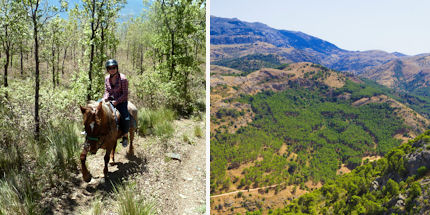 Riding along the old Moorish trails
Riding along the old Moorish trails Andy Neidhardt and iStockphoto / Thinkstock
We begin our trek up the narrow dirt road and before long I am happily settled into Molly’s saddle, staring out at the snow-topped mountains against the glinting Mediterranean Sea.
Tina shows us the Órgiva valley, points out the tepees of the ever-growing Beneficio ecovillage, a sustainable community who have shunned modern trappings, and confirms that the aromas we can smell are the rosemary, oregano and thyme bushes that bristle around us. We attempt trotting, but despite Molly’s perseverance, I can’t get the rhythm right. Nor can I ignore my partner’s laughter as he watches me awkwardly bounce around.
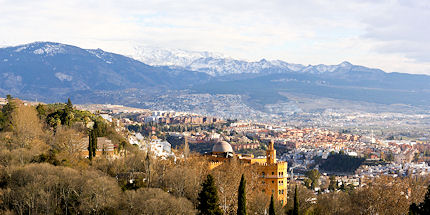 The snowy peaks of the Sierra Nevada
The snowy peaks of the Sierra NevadaiStockphoto / Thinkstock
When the path ends, we have a steep incline straight through the fields, and as we battle up the mountainside with the breeze whistling around us and not another soul in sight, I feel like a bona fide Butch Cassidy.
Next we head through the logging trails of the pine forests and stop for lunch in the welcome shade. Four hours have flown by and we need to begin our descent down the mountainside; Molly picks up her pace as she realises it’s home time.
Back at the stables, we slide off our saddles and head to our lodgings for the night – a wonderful 300-year-old farmhouse. Here we relax with a beer, take a dip in the spring-water pool… and wonder how long it will take to regain feeling in our backsides.
Beaches beckon: Cabo de Gata
As we drive eastwards, the greenery fades away and is replaced by gigantic red rocks. The Cabo de Gata coastline in Almería is home to Spain's largest volcanic rock formation and is made up of towns stretching from Almadraba de Monteleva in the south to Agua Amarga in the north. We’ve opted for San José, near the south. The most tourist-oriented of the towns, San Jose’s central street, Calle Correo, is lined with restaurants that continue to the beachfront, but they are tastefully done, without an English pub in sight.
As it’s almost 7pm when we arrive, we head off on the short walk to the beach in jeans and t-shirts. But just 10 minutes of strolling along the clean, white sand, with its tempting clear seas and we can take it no more…Fifteen minutes later, after a sprint back to the hotel to grab our swimming gear, we’re wading in the cool waters.
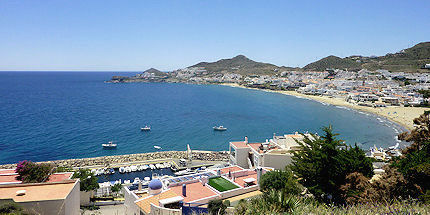 The beachy coastline of San Jose
The beachy coastline of San JoseCherry Casey
A UNESCO biosphere reserve since 1997, Cabo de Gata’s offshore coral reefs and marine life are the perfect place for diving. The coastline also deserves exploring; you can walk, cycle or drive along dramatic cliff-top routes.
Blaming a lack of sensible shoes, we opt for the car and head south towards the salinas (salt lagoons that are often home to flamingo colonies) and past the eerily desolate Iglesia de las Salinas, before stopping off at an unexpected sandy cove for an impromptu swim.
Back in San José in time for the sunset, we marvel at how this beautifully rugged beach resort has – for now – managed to keep the hoards at bay.
Enraptured by Ronda
As the pint-sized flamenco dancers pass us by, one shyly presses something into my hand. I look down to find ‘Virgen de la Cabeza’ printed in big letters on a tiny card. We’re at the annual religious pilgrimage in the town of Ronda, and watch as teenage dancers show off their flamenco moves to nothing but a drumbeat and timely clapping. A brass band brings up the rear and the procession continues downhill, marking the beginning of a fiesta that will no doubt last well into the night.
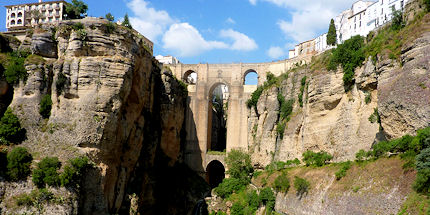 The landmark bridge, Puente Nuevo
The landmark bridge, Puente NuevoCherry Casey
It’s only after heading into the Old Town that we quickly lose ourselves – and everyone else – winding through the quiet medieval lanes, where Moorish architecture sits side by side with quintessentially Spanish buildings.
After a cerveza at the Plaza María Auxiliadora, we find the winding dirt track that leads down towards the El Tajo gorge, on which the two districts of Ronda are perched facing each other. We follow the path as it gets increasingly narrow until we are cut off by a miniature waterfall shooting out from the Puente Nuevo – the city’s landmark bridge immortalised in Hemingway’s For Whom the Bell Tolls. Looking up at the colossal baroque monument from this hidden viewpoint, next to the crumbling ruins of an old building, the sense of this town’s historical significance overwhelms. While you may have to work to escape the crowds in Ronda, falling under its spell is easy.
Unassuming Osuna
En route to the airport, our hire car is rapidly running out of petrol. We’re forced to make an unscheduled pit-stop at Osuna in the province of Seville.
After parking in front of a desolate, grey shopping mall, we’re apprehensive about what Osuna has to offer. But after tentatively continuing on foot down a main road, all fears are allayed: we arrive at the mosaic-tiled Plaza Mayor, surrounded by Renaissance-era buildings and lined with orange trees. On the cusp of siesta time, the plaza is peaceful; elderly gents gather round the benches to shoot the breeze and excited teens head home from school.
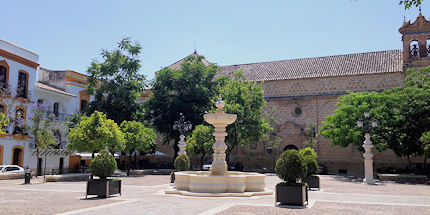 The peaceful Plaza Mayor
The peaceful Plaza MayorCherry Casey
From here, we look up to see the The Colegiata de Santa Maria de la Asuncion – a grand 16th-century church sat majestically on top of a hill. Opposite, the Monasterio de la Encarnación houses a vast collection of fine artwork.
We continue our stroll when we spot the picture-perfect Calle San Pedro featuring two 18th century baroque palaces, the Cilla del Cabildo and the Palacio de los Marqueses de la Gomera (now a hotel).
Historical information outside such buildings is translated into English, suggesting tourists are both expected and welcome. But as we wander the quiet streets, it seems Osuna is not yet on most people’s radar, and we revel in the opportunity to experience a town steeped in history, yet free from crowds.
NEED TO KNOW
When to go: Andalucía can get oppressively hot in July and August, so springtime (24-27C) or early autumn (26-32C) is ideal for more manageable sunny days.
Getting there: Various airlines fly directly from UK to Seville, Málaga, Almería and Granada, all good gateways for exploring this region.
Do you have any Feedback about this page?
© 2025 Columbus Travel Media Ltd. All rights reserved. No part of this site may be reproduced without our written permission, click here for information on Columbus Content Solutions.









 You know where
You know where